Transient Flow Structures and Energy Loss Mechanisms of a Multistage Pump as a Turbine Under Runaway Conditions
Abstract
1. Introduction
2. Methodology
2.1. Research Subject
2.2. Research Method
3. Results and Analysis
3.1. Entropy Production Characteristics Analysis of the Multistage PAT Under Runaway Conditions
3.2. Flow Structure Analysis of the Multistage PAT Under Runaway Conditions
3.3. Transient Characteristics Analysis of the Multistage PAT Under Runaway Conditions
4. Conclusions
Author Contributions
Funding
Data Availability Statement
Conflicts of Interest
Abbreviations
| PAT | Pumps as turbines |
| SAF | Soft abrasive flow finishing |
| CFD | Computational fluid dynamics |
| VOF | Volume of Fluid |
| BPF | Blade-passing frequency |
| LEPTR | Flow entropy production |
| LEPWR | Wall entropy production |
| TEPR | Turbulent entropy production rate |
| EPWR | Entropy production wall rate |
| LEPDR | Local entropy production direct rate |
| LEPWR | Local entropy production wall rate |
| LEPTR | Local entropy production total rate |
| EPTR | Entropy production total rate |
| TKE | Turbulence kinetic energy |
| RN | Runner |
| DF | Diffuser |
| HC | Hub chamber |
| SC | Shroud chamber |
References
- Wang, Z.Q.; Wang, W.J.; Wang, D.X.; Song, Y. Numerical analysis of energy loss characteristics of guide vane centrifugal pump as turbine. Front. Energy Res. 2024, 12, 1410679. [Google Scholar] [CrossRef]
- Kan, K.; Zhao, F.; Xu, H.; Feng, J.G.; Chen, H.X.; Liu, W.D. Energy performance evaluation of an axial-flow pump as turbine under conventional and reverse operating modes based on an energy loss intensity model. Phys. Fluids 2023, 35, 015125. [Google Scholar] [CrossRef]
- Song, X.J.; Wang, Z.W.; Jin, Y.; Liu, C.; Presas, A.; Tang, F.P.; Lu, Y.G. Research on the mechanism of the effect of vortex on the hydraulic loss of pump as turbine units based on entropy production theory. Renew. Energy 2025, 239, 122048. [Google Scholar] [CrossRef]
- Yu, A.; Tang, Y.B.; Tang, Q.H.; Cai, J.G.; Zhao, L.; Ge, X.F. Energy analysis of Francis turbine for various mass flow rate conditions based on entropy production theory. Renew. Energy 2022, 183, 447–458. [Google Scholar] [CrossRef]
- Li, X.J.; Cao, Z.T.; Wei, Z.C.; Ren, Q.L. Theoretical model of energy conversion and loss prediction for multi-stage centrifugal pump as turbine. Energy Convers. Manag. 2025, 325, 119379. [Google Scholar] [CrossRef]
- Ghorani, M.M.; Haghighi, M.H.S.; Maleki, A.; Riasi, A. A numerical study on mechanisms of energy dissipation in a pump as turbine (PAT) using entropy generation theory. Renew. Energy 2020, 162, 1036–1053. [Google Scholar] [CrossRef]
- Lin, T.; Li, X.J.; Zhu, Z.C.; Xie, J.; Li, Y.; Yang, H. Application of enstrophy dissipation to analyze energy loss in a centrifugal pump as turbine. Renew. Energy 2021, 163, 41–55. [Google Scholar] [CrossRef]
- Feng, J.J.; Zhang, Y.; Zhu, G.J.; Li, J.Z.; Li, W.F. Transition process characteristics of centrifugal pump with power-off based on entropy production theory. Trans. Chin. Soc. Agric. Eng. 2020, 36, 10–17. [Google Scholar]
- Ge, Z.G.; Feng, J.J.; Wu, Y.J.; Yang, Z.B.; Zhang, Y.; Zhu, G.J.; Luo, X.Q. Numerical analysis on characteristics of transient process in centrifugal pumps during power failure under large flow initial condition. Chin. J. Hydrodyn. 2022, 37, 452–458. [Google Scholar] [CrossRef]
- Xu, Z.; Zhen, Y.; Kan, K.; Huang, J.C. Runaway characteristics of bidirectional horizontal axial flow pump with super low head based on entropy production theory. Trans. Chin. Soc. Agric. Eng. 2021, 37, 49–57. [Google Scholar]
- Si, Q.; Xia, X.; Wu, K.; Deng, F.; Yuan, S. Transient characteristics of the hydraulic transition process of emergency water supplymulti-stage pump with unexpected shutdown. Trans. Chin. Soc. Agric. Eng. 2024, 40, 72–81. [Google Scholar] [CrossRef]
- Ouyang, T. Interstage Flow Characteristics and Deterministic Analysis of Multistage Centrifugal Pump as Turbine. Master’s Thesis, Zhejiang Sci-Tech University, Hangzhou, China, 2023. [Google Scholar] [CrossRef]
- Cui, M.M.; Shen, J.W. Influence of Rotational Speeds on Pressure Pulsation Under Low Flow Conditions. Heilongjiang Sci. 2025, 16, 37–42. [Google Scholar]
- Yu, T.; Shuai, Z.J.; Wang, X.; Jian, J.; Li, W.Y.; Jiang, C.X.; Xiao, Q. A study on instability mechanism of a pump-valve coupling system in low flow rate. J. Vib. Shock 2023, 42, 137–144. [Google Scholar] [CrossRef]
- Zhou, Q.; Xia, L.S.; Zhang, C.Z. Internal mechanism and improvement criteria for the runaway oscillation stability of a pump-turbine. Appl. Sci. 2018, 8, 2193. [Google Scholar] [CrossRef]
- Tchada, M.; Tchoumboué, K.; Mesquita, A. Enhancing Pump as Turbine (PAT) performances: A numerical investigation into the impact of impeller leading edge rounding. Heliyon 2024, 10, e34663. [Google Scholar] [CrossRef]
- Zhao, Z.L.; Guo, Z.W.; Qian, Z.D.; Cheng, Q. Performance improvement of an axial-flow pump with inlet guide vanes in the turbine model. Proc. Inst. Mech. Eng. Part A J. Power Energy 2020, 234, 323–331. [Google Scholar] [CrossRef]
- Wei, Y.Y.; Shi, Y.H.; Zhang, Q.; Shi, W.D. Numerical investigation of unsteady pressure pulsation characteristics in an ultra-low specific-speed centrifugal pump as a turbine. Front. Energy Res. 2023, 10, 1026886. [Google Scholar] [CrossRef]
- Binama, M.; Kan, K.; Chen, H.X.; Zheng, Y.; Zhou, D.Q.; Su, W.T.; Ge, X.F.; Ndayizigiye, J. A Numerical Investigation into the PAT Hydrodynamic Response to Impeller Rotational Speed Variation. Sustainability 2021, 13, 7998. [Google Scholar] [CrossRef]
- Zhang, R.; Chen, L.; Zeng, Y. Numerical simulations of cavitation flow characteristics of centrifugal pump impeller under large flow conditions. J. Hydroelectr. Eng. 2025, 44, 10–21. [Google Scholar]
- Trivedi, C.; Cervantes, M.J.; Gandhi, B.K. Investigation of a high head Francis turbine at runaway operating conditions. Energies 2016, 9, 149. [Google Scholar] [CrossRef]
- Shi, Z.X. Research on the Effect of Tip Clearance and Guide Vanes on the Performance of Axial Pump as Turbine. Master’s Thesis, Lanzhou University of Technology, Lanzhou, China, 2021. [Google Scholar] [CrossRef]
- Li, Q.F.; Zhao, C.B.; Long, S.C.; Quan, H. A study on the evolution of vortex in the draft tube of pump-turbine under the runaway condition. J. Vib. Shock 2019, 38, 222–228. [Google Scholar] [CrossRef]
- Miao, S.C.; Li, G.Z.; Zhang, Q.L.; Wang, X.H. Research on Transient Flow Characteristics of Axial-flow Pump as Hydraulic Turbine during Runaway Transition. J. Eng. Therm. Energy Power 2024, 39, 22–29. [Google Scholar]
- Miao, S.C.; Zhang, H.B.; Tian, W.L.; Li, Y.Q. A Study on the Unsteady Flow Characteristics and Energy Conversion in the Volute of a Pump-as-Turbine Device. Fluid Dyn. Mater. Process. 2021, 17, 1021–1036. [Google Scholar] [CrossRef]
- Wang, P.; Gao, J.W.; Luo, X.; Lu, J.L.; Xue, Q.Y.; Zhu, G.J. Study on runaway characteristics of tubular turbine for residual pressure power generation. J. Hydroelectr. Eng. 2022, 41, 122–134. [Google Scholar]
- Zhang, C.Y.; Pei, J.; Yuan, S.Q.; Wang, W.J.; Gan, X.C. Analysis of internal flow characteristics during runaway transition of inline pump turbine as turbine. Chin. J. Hydrodyn. 2021, 36, 830–834. [Google Scholar] [CrossRef]
- Govender, M.; Ikegwuoha, C.D.; Seyam, M. A CFD-Based Study of Pipe Leakage Dynamics and Water Management Impacts. Water Resour. Manag. 2025, 1–14. [Google Scholar] [CrossRef]
- Karpenko, M. Aircraft hydraulic drive energy losses and operation delay associated with the pipeline and fitting connections. Aviation 2024, 28, 1–8. [Google Scholar] [CrossRef]
- Lu, Y.G.; Xin, L.C.; Hu, N.M. Influences of floating ice on the water entry process of slender body on the cavity evolution and hydrodynamic characteristics. Phys. Fluids 2025, 37, 0261877. [Google Scholar] [CrossRef]
- Chen, X.X.; Hou, T.Y.; Liu, S.L.; Guo, Y.X.; Hu, J.P.; Xu, G.M.; Ma, G.X.; Liu, W. Design of a Micro-Plant Factory Using a Validated CFD Model. Agriculture 2024, 14, 2227. [Google Scholar] [CrossRef]
- Chen, H.Z.; Liu, X.S.; Li, H.R.; Zhu, R.S.; Fu, Q.; Lu, Y.G. Pressure distribution characteristics in pump chamber and axial force optimization of reactor coolant pump. Phys. Fluids 2025, 37, 015159. [Google Scholar] [CrossRef]
- Liu, Z.W.; Lu, Y.G.; Li, X.L.; Wang, Z.W.; Alexandre, P. Research on the influence mechanism of operating characteristics of an 11-stage pump as turbine under turbine mode. Proc. Inst. Mech. Eng. Part A J. Power Energy 2025, 239, 501–513. [Google Scholar] [CrossRef]
- Lu, Y.G.; Liu, Z.W.; Zhao, Y.; Wang, Z.W.; Presas, A. Study on evolution characteristics of energy dissipation and vortex in pump- turbine during load rejection transition process. Phys. Fluids 2025, 37, 025104. [Google Scholar] [CrossRef]
- Xu, L.Z.; Hansen, A.C.; Li, Y.M.; Liang, Z.W.; Yu, L.J. Numerical and experimental analysis of airflow in a multi-duct cleaning system for a rice combine harvester. Trans. ASABE 2016, 59, 1101–1110. [Google Scholar] [CrossRef]
- Jiang, Y.; Li, H.; Hua, L.; Zhang, D.M. Three-dimensional flow breakup characteristics of a circular jet with different nozzle geometries. Biosyst. Eng. 2020, 193, 216–231. [Google Scholar] [CrossRef]


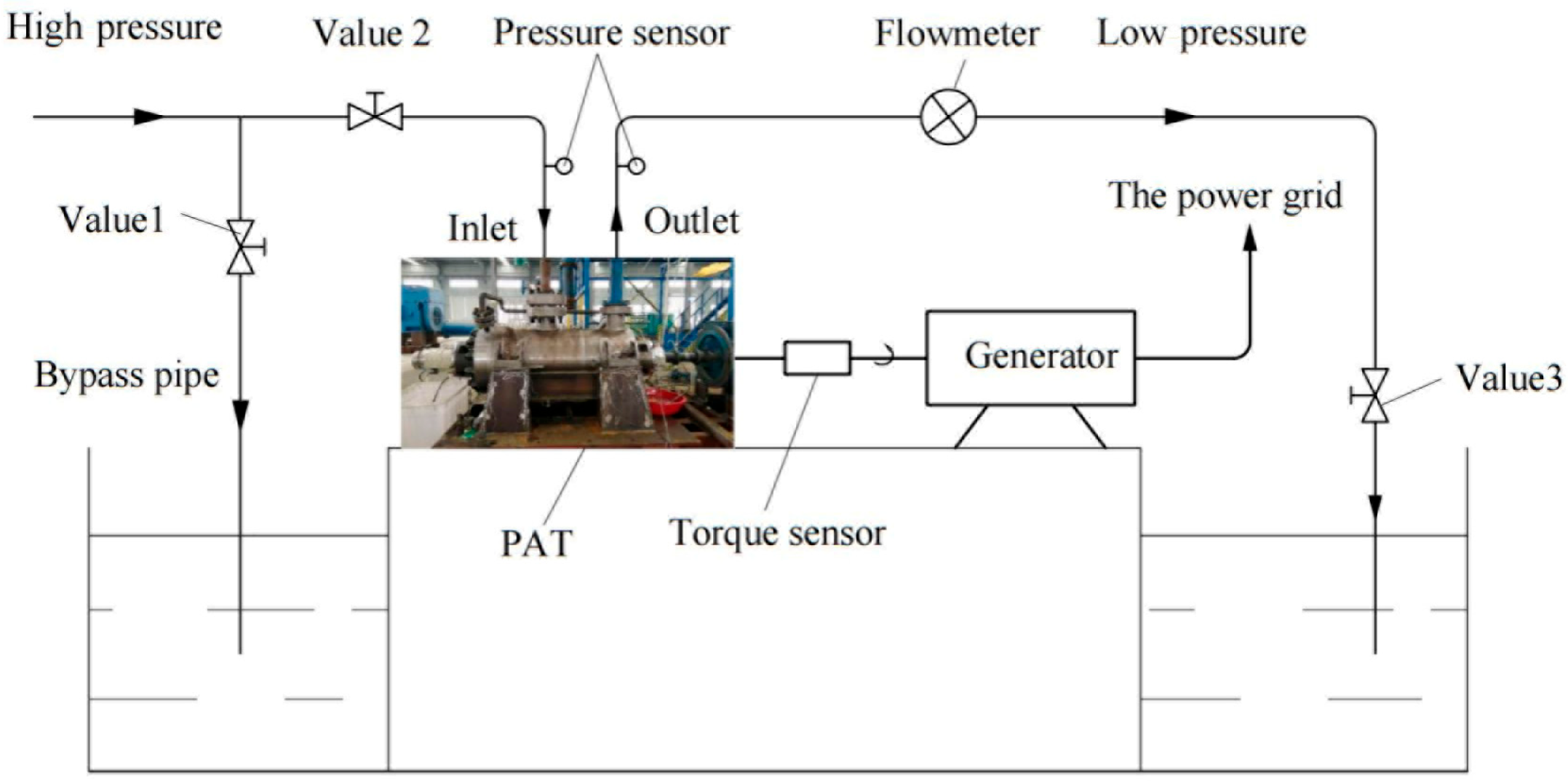
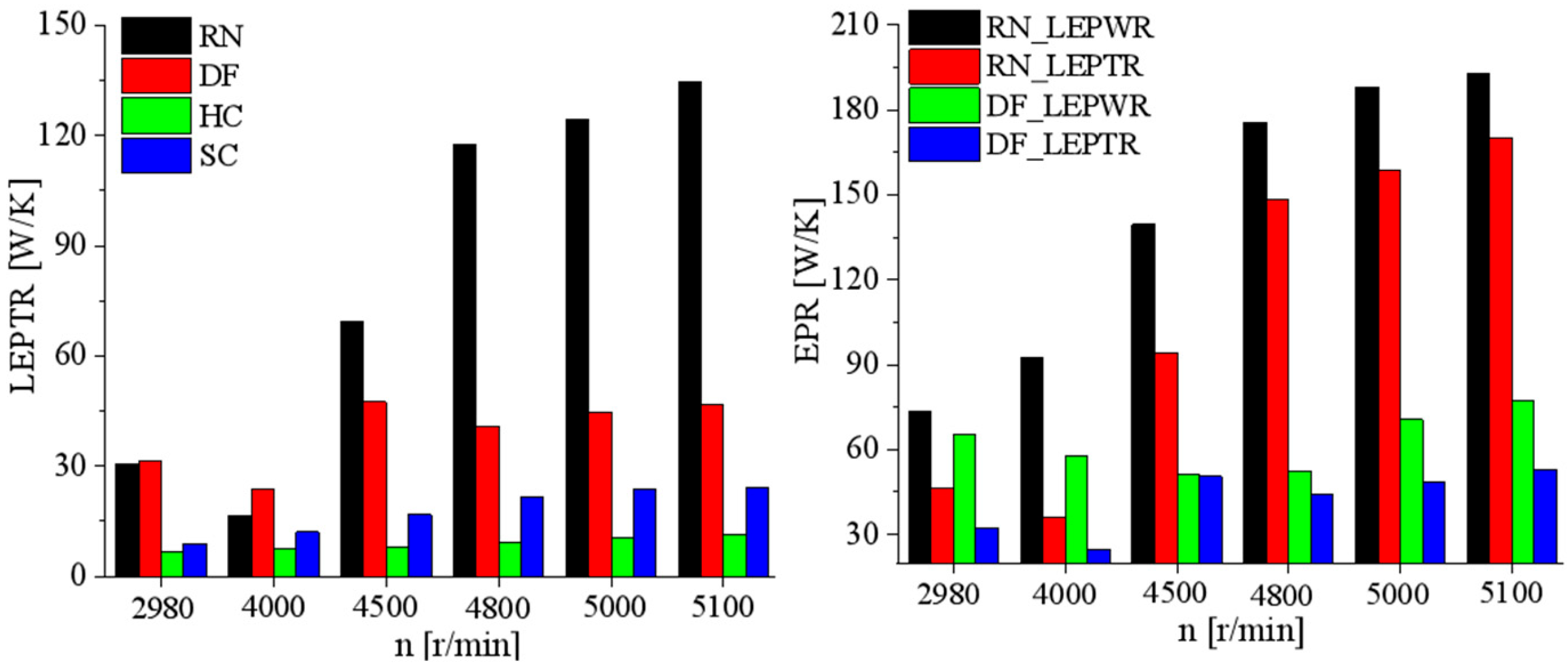
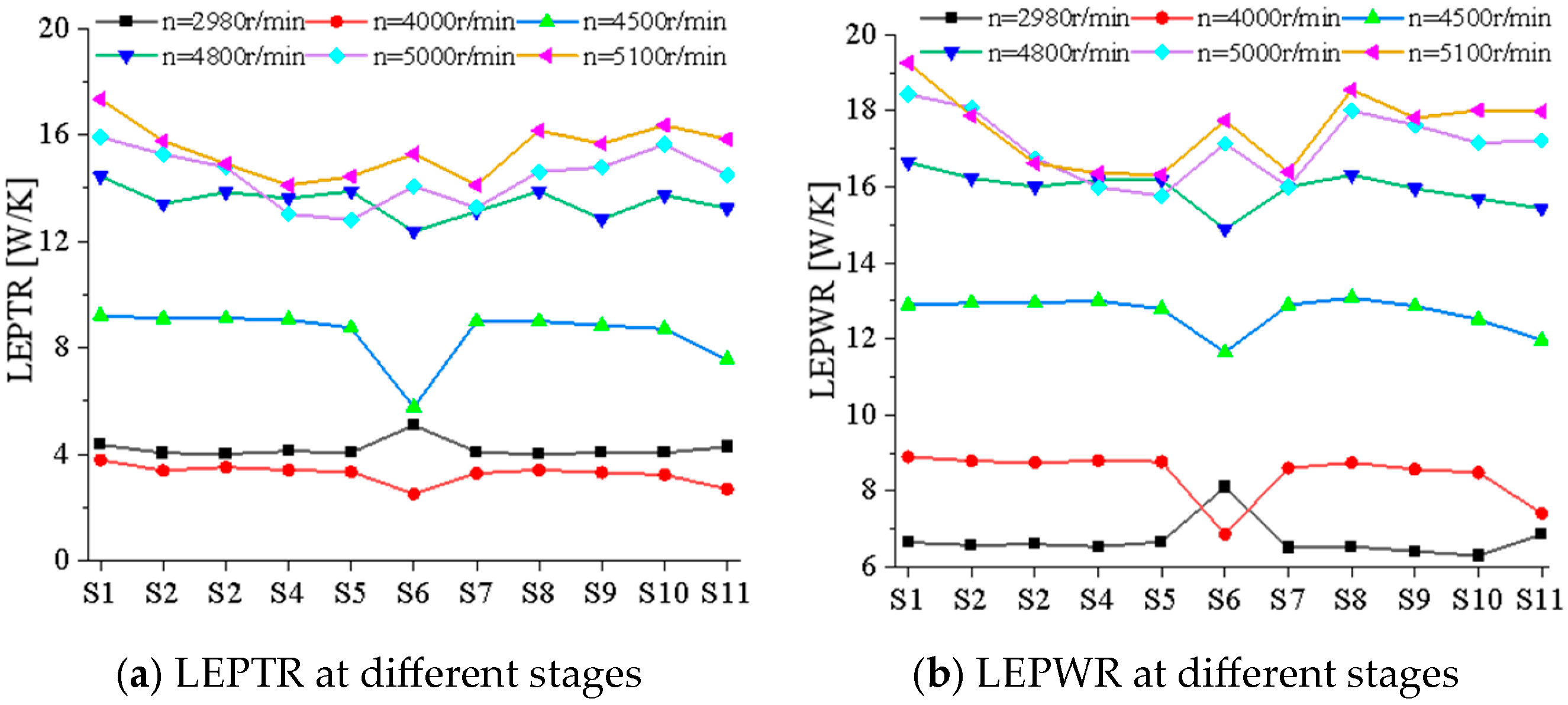
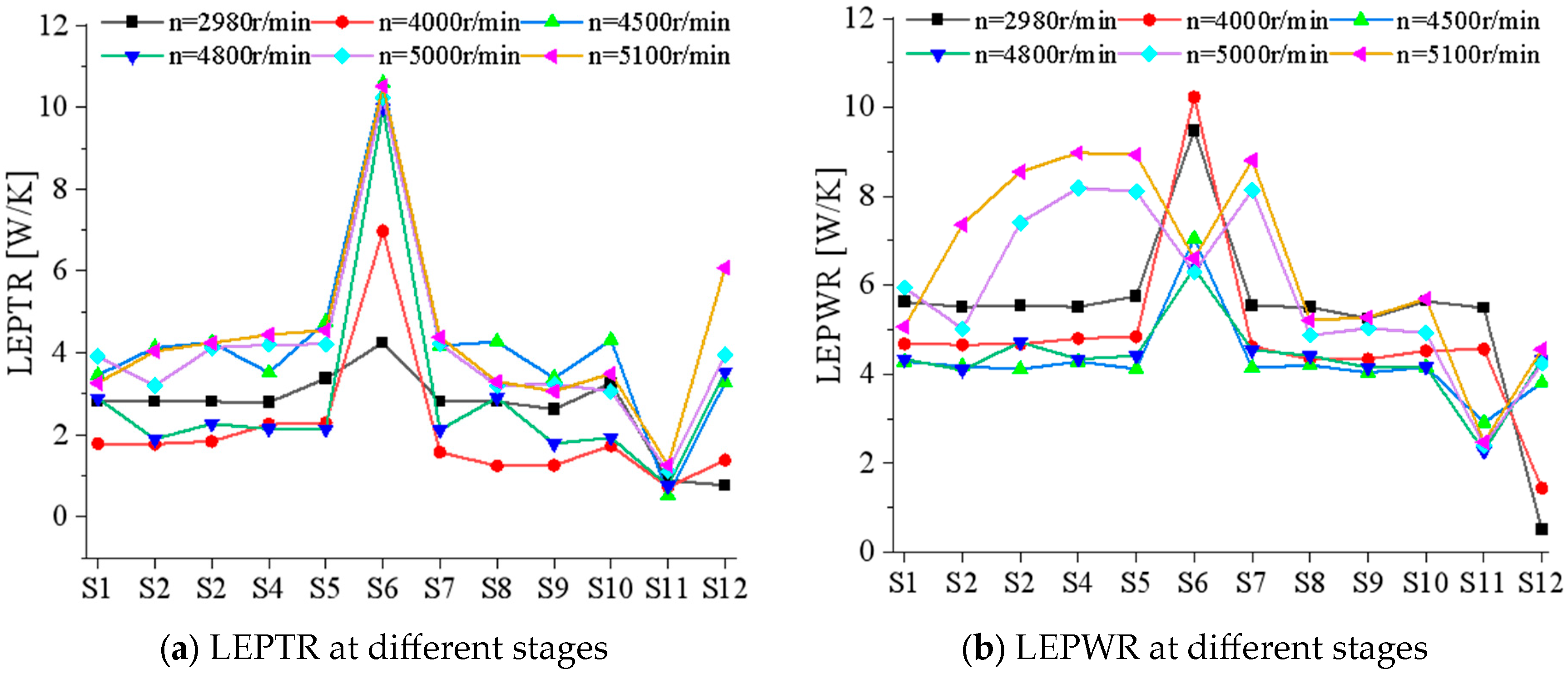
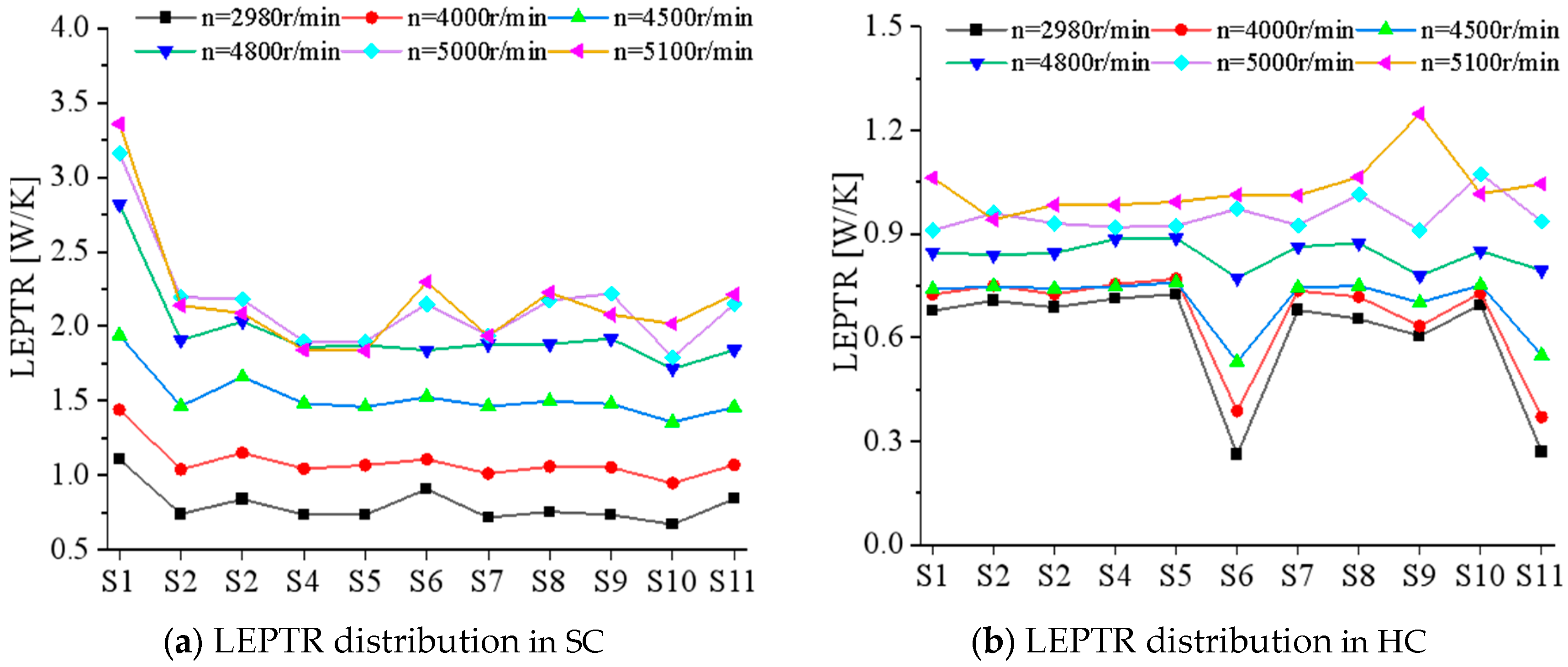
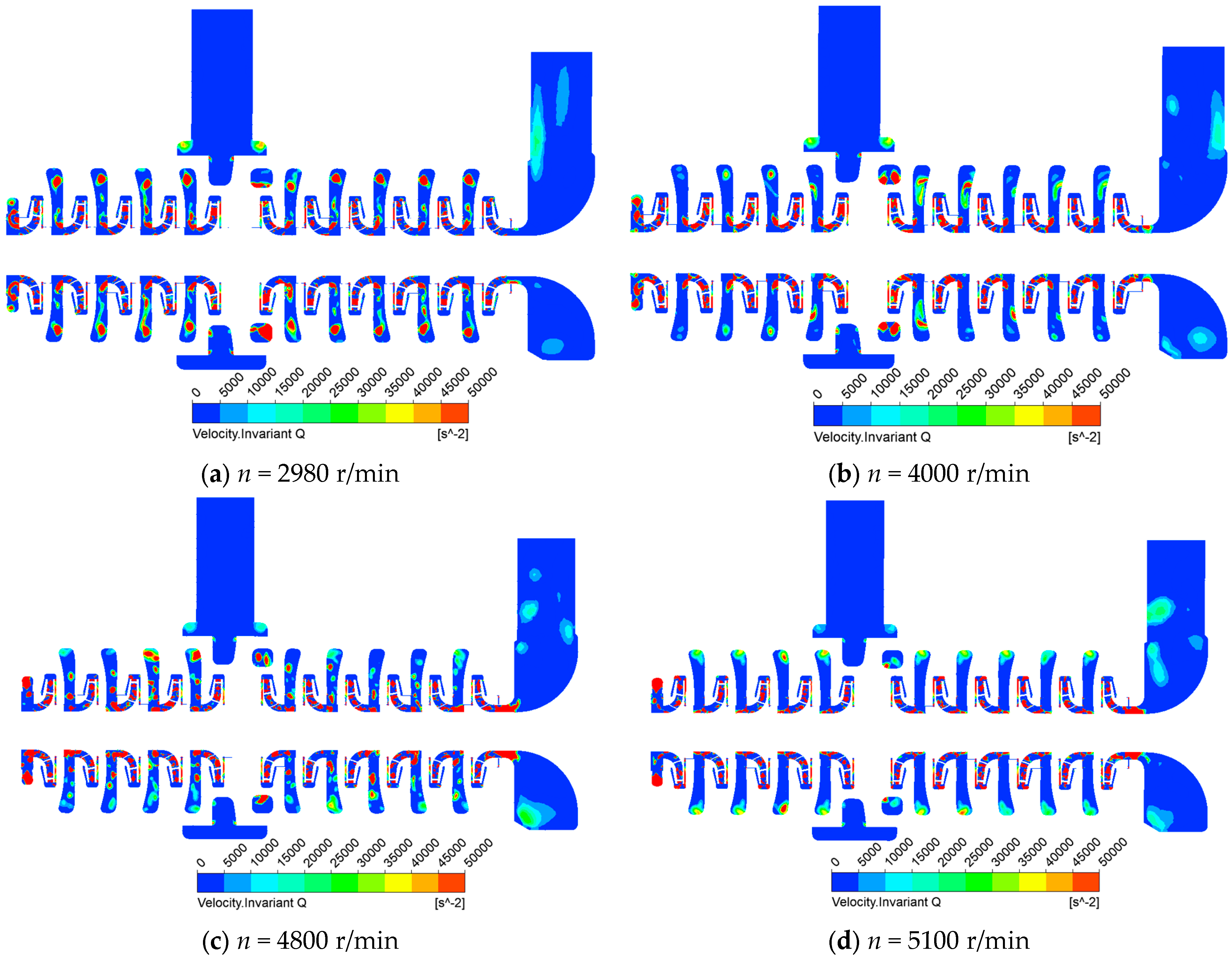

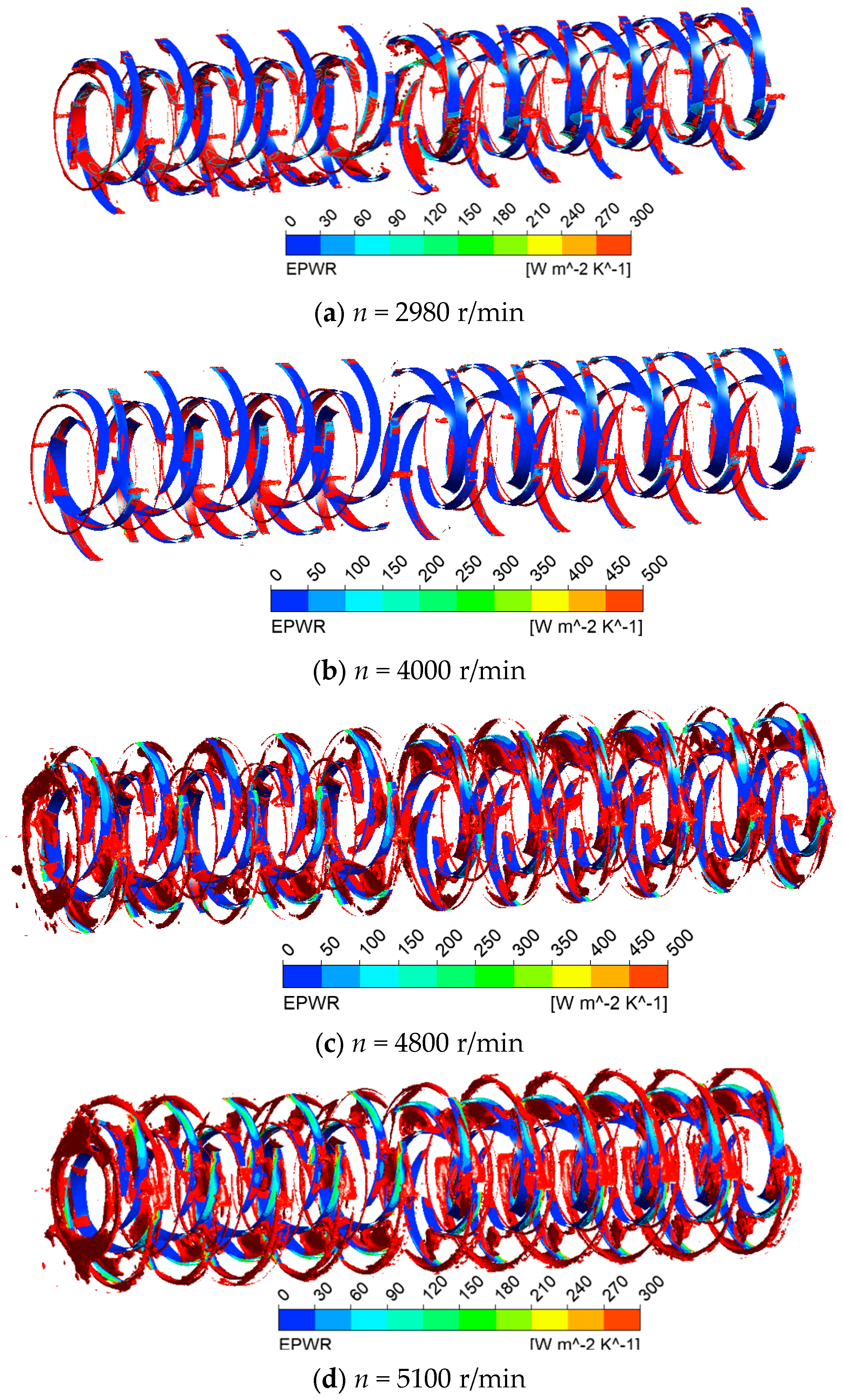


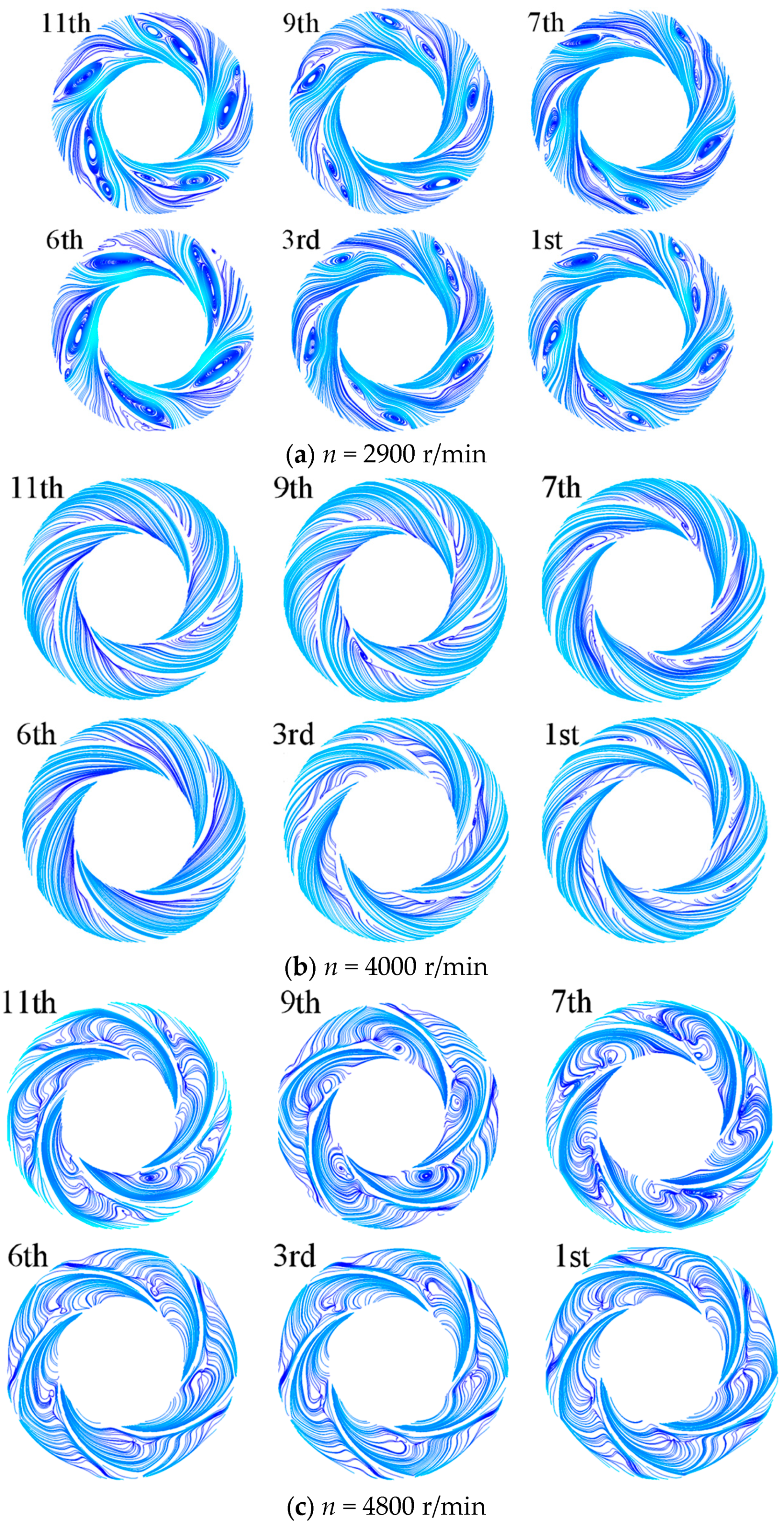
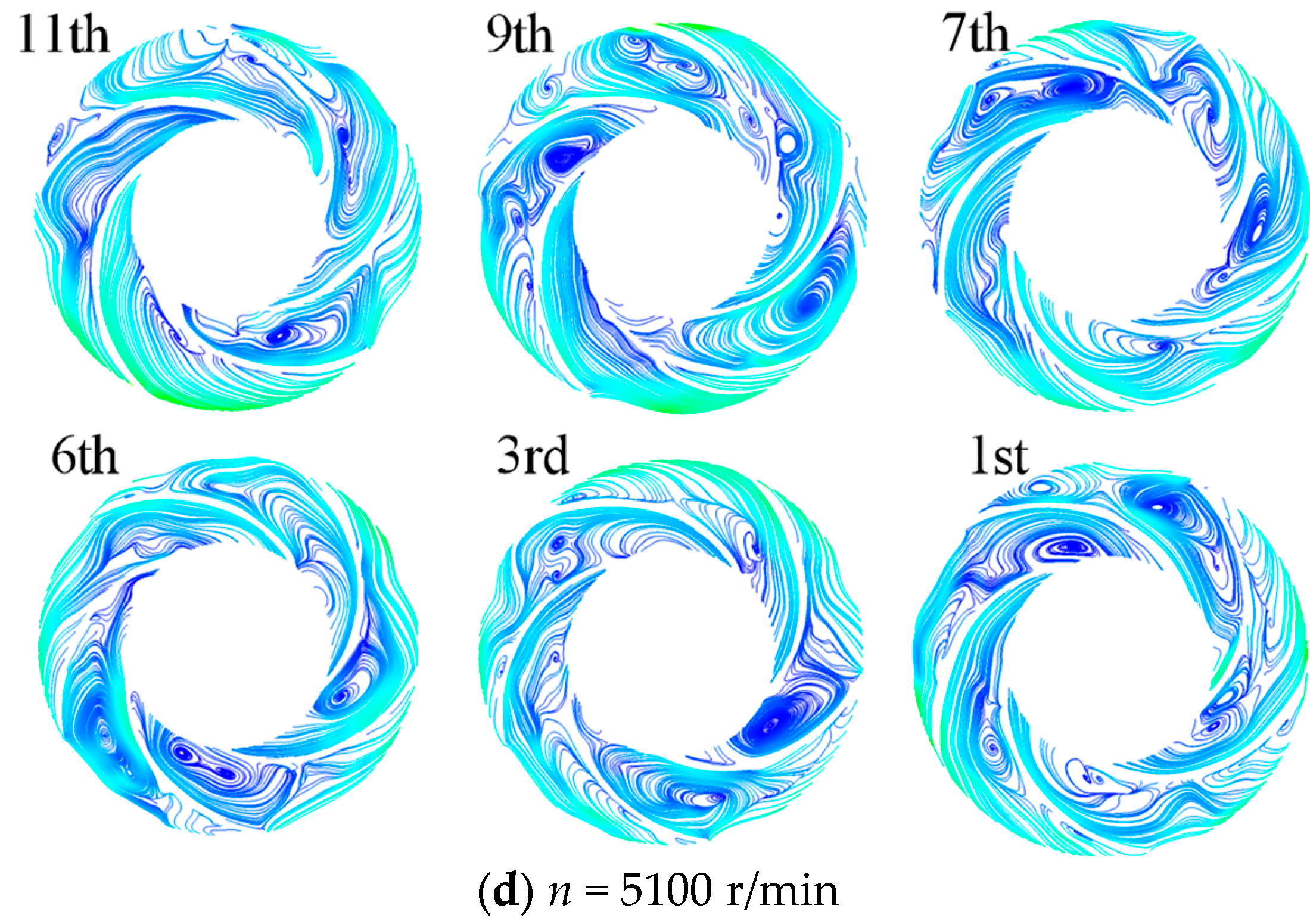
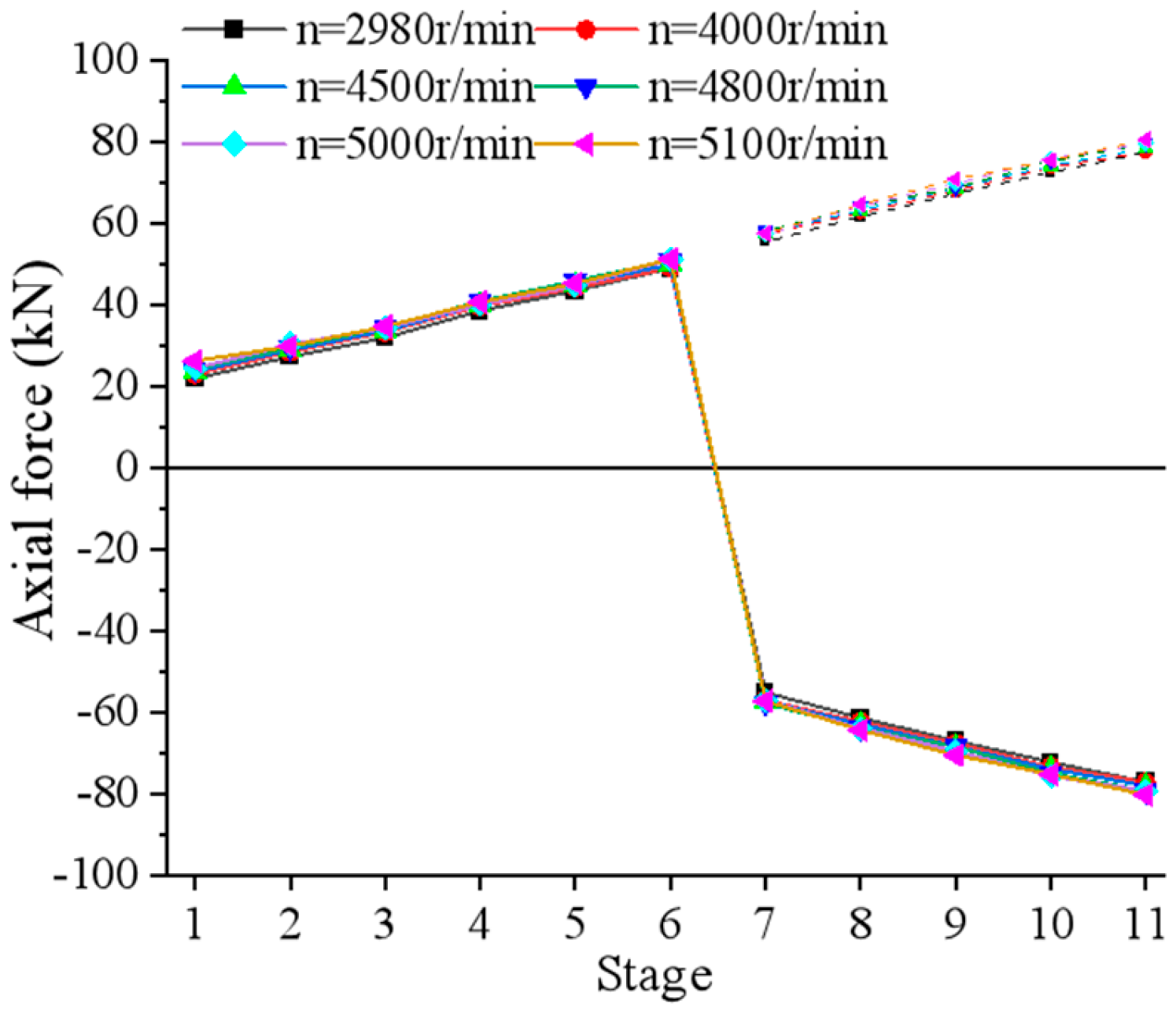
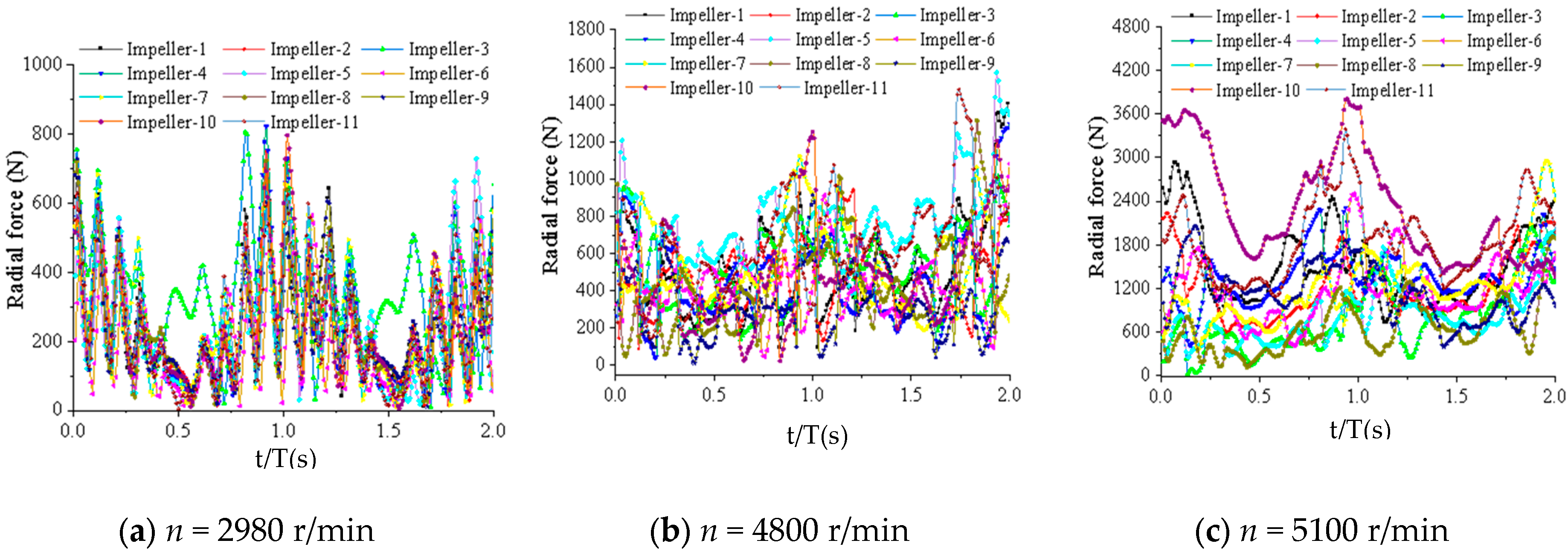

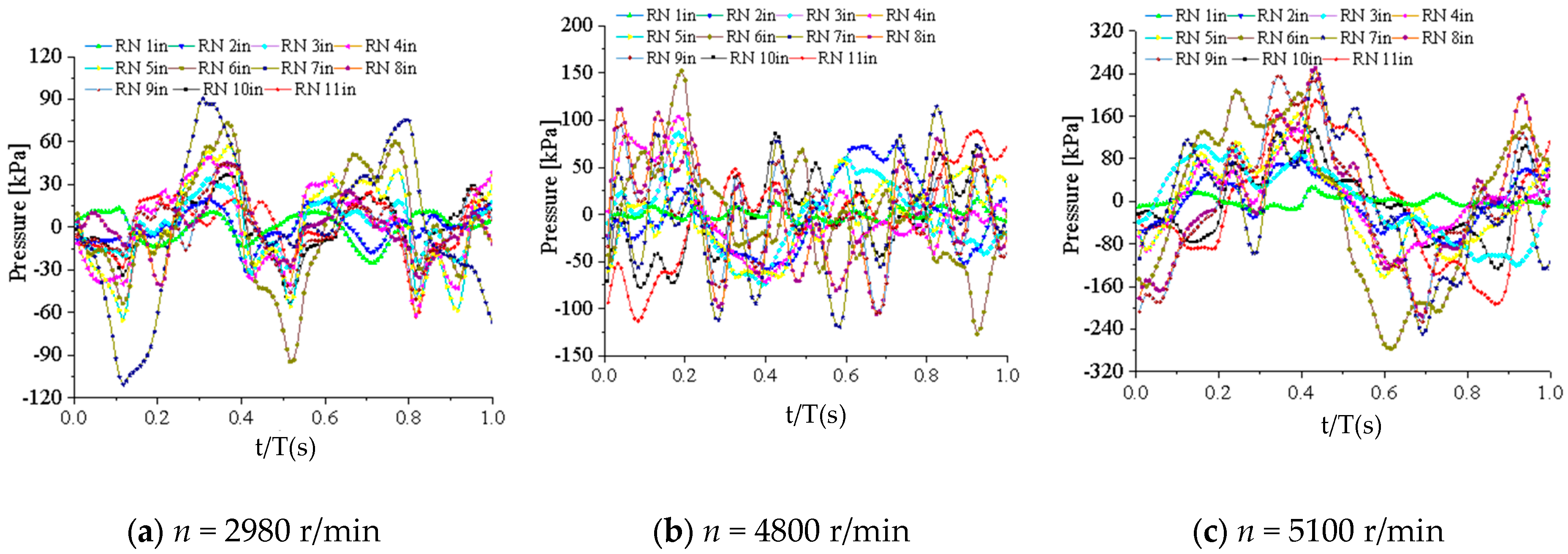
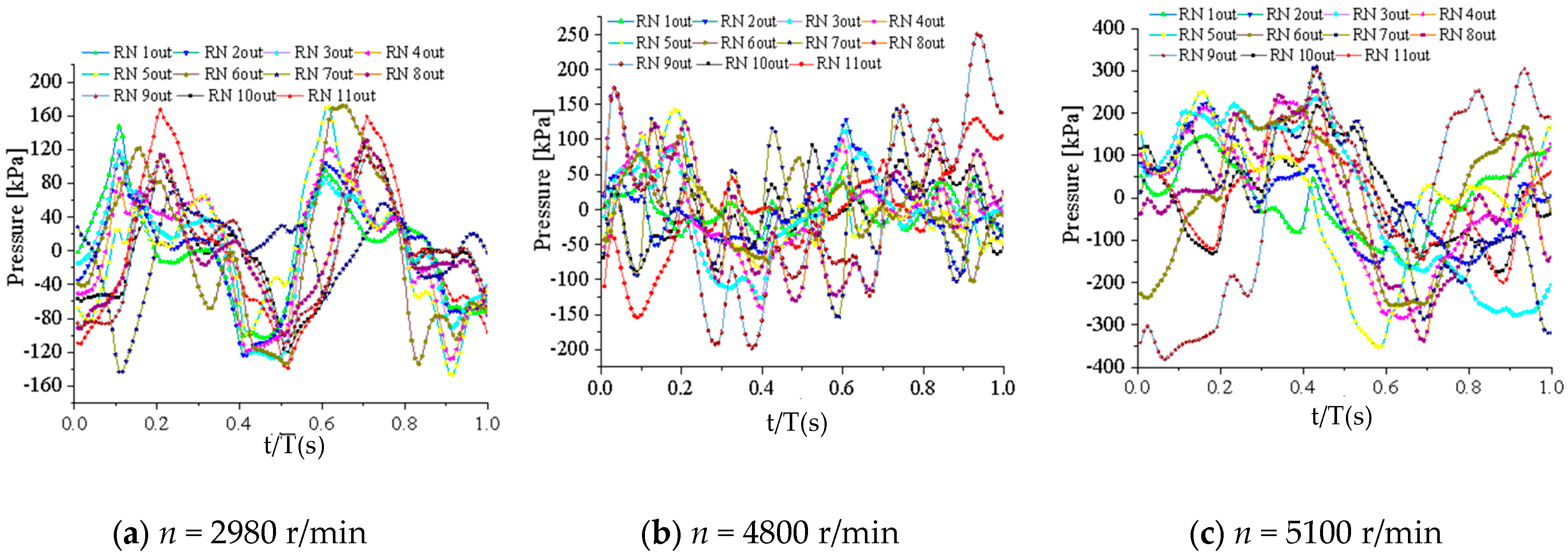
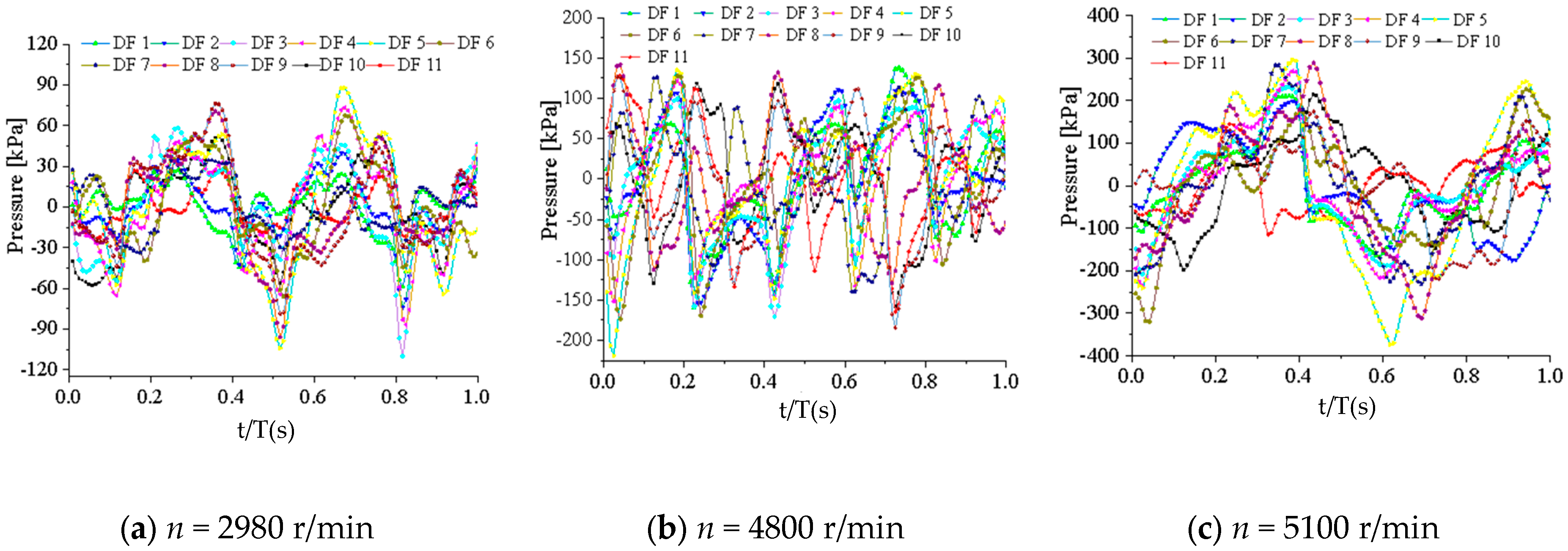



| Name | Value | Unit |
|---|---|---|
| Rated flow under turbine condition QT | 179 | m3/h |
| Inlet pressure under turbine condition | 15 | MPa |
| Outlet pressure under turbine condition | 2.5 | MPa |
| Rated speed under turbine condition nt | −2980 | r/min |
| The density of the medium | 726 | kg/m3 |
| diameter at the inlet of a runner D1 | 136 | mm |
| Runner hub diameter dh | 99 | mm |
| Runner wheel diameter D2 | 265 | mm |
| Runner blades number Z | 5 | / |
| Flow (m3/h) | Speed (r/min) | Kilowatts (kW) | Efficiency (%) |
|---|---|---|---|
| 207 | 2980 | 545.1 | 76.62 |
| 190.7 | 4000 | 519.4 | 78.48 |
| 156.8 | 4500 | 310.6 | 57.07 |
| 132.5 | 4800 | 193.8 | 42.14 |
| 119.9 | 5000 | 94.2 | 22.65 |
| 105.1 | 5100 | 10.6 | 2.35 |
| Plan | Total (106) | Head (m) | Efficiency (%) |
|---|---|---|---|
| 1 | 9.2 | 1580.5 | 75.5 |
| 2 | 11.5 | 1628.2 | 77.9 |
| 3 | 13.3 | 1650.3 | 78.7 |
| 4 | 15.72 | 1658.0 | 79.3 |
| 5 | 18.6 | 1660.1 | 79.5 |
| 6 | 22.8 | 1661.6 | 79.7 |
| 7 | 25.4 | 1660.5 | 79.6 |
| Head (m) | Power (kW) | Efficiency (%) | |
|---|---|---|---|
| Experiment | 1756 | 478 | 76.9 |
| Simulation | 1658 | 467 | 79.3 |
| Relative Error | 5.55% | 2.30% | 3.12% |
Disclaimer/Publisher’s Note: The statements, opinions and data contained in all publications are solely those of the individual author(s) and contributor(s) and not of MDPI and/or the editor(s). MDPI and/or the editor(s) disclaim responsibility for any injury to people or property resulting from any ideas, methods, instructions or products referred to in the content. |
© 2025 by the authors. Licensee MDPI, Basel, Switzerland. This article is an open access article distributed under the terms and conditions of the Creative Commons Attribution (CC BY) license (https://creativecommons.org/licenses/by/4.0/).
Share and Cite
Lin, P.; Xiong, Y.; Li, X.; Lu, Y.; Hu, D.; Lu, W.; Peng, J. Transient Flow Structures and Energy Loss Mechanisms of a Multistage Pump as a Turbine Under Runaway Conditions. Energies 2025, 18, 4528. https://doi.org/10.3390/en18174528
Lin P, Xiong Y, Li X, Lu Y, Hu D, Lu W, Peng J. Transient Flow Structures and Energy Loss Mechanisms of a Multistage Pump as a Turbine Under Runaway Conditions. Energies. 2025; 18(17):4528. https://doi.org/10.3390/en18174528
Chicago/Turabian StyleLin, Peng, Yuting Xiong, Xiaolong Li, Yonggang Lu, Dong Hu, Wei Lu, and Jin Peng. 2025. "Transient Flow Structures and Energy Loss Mechanisms of a Multistage Pump as a Turbine Under Runaway Conditions" Energies 18, no. 17: 4528. https://doi.org/10.3390/en18174528
APA StyleLin, P., Xiong, Y., Li, X., Lu, Y., Hu, D., Lu, W., & Peng, J. (2025). Transient Flow Structures and Energy Loss Mechanisms of a Multistage Pump as a Turbine Under Runaway Conditions. Energies, 18(17), 4528. https://doi.org/10.3390/en18174528







